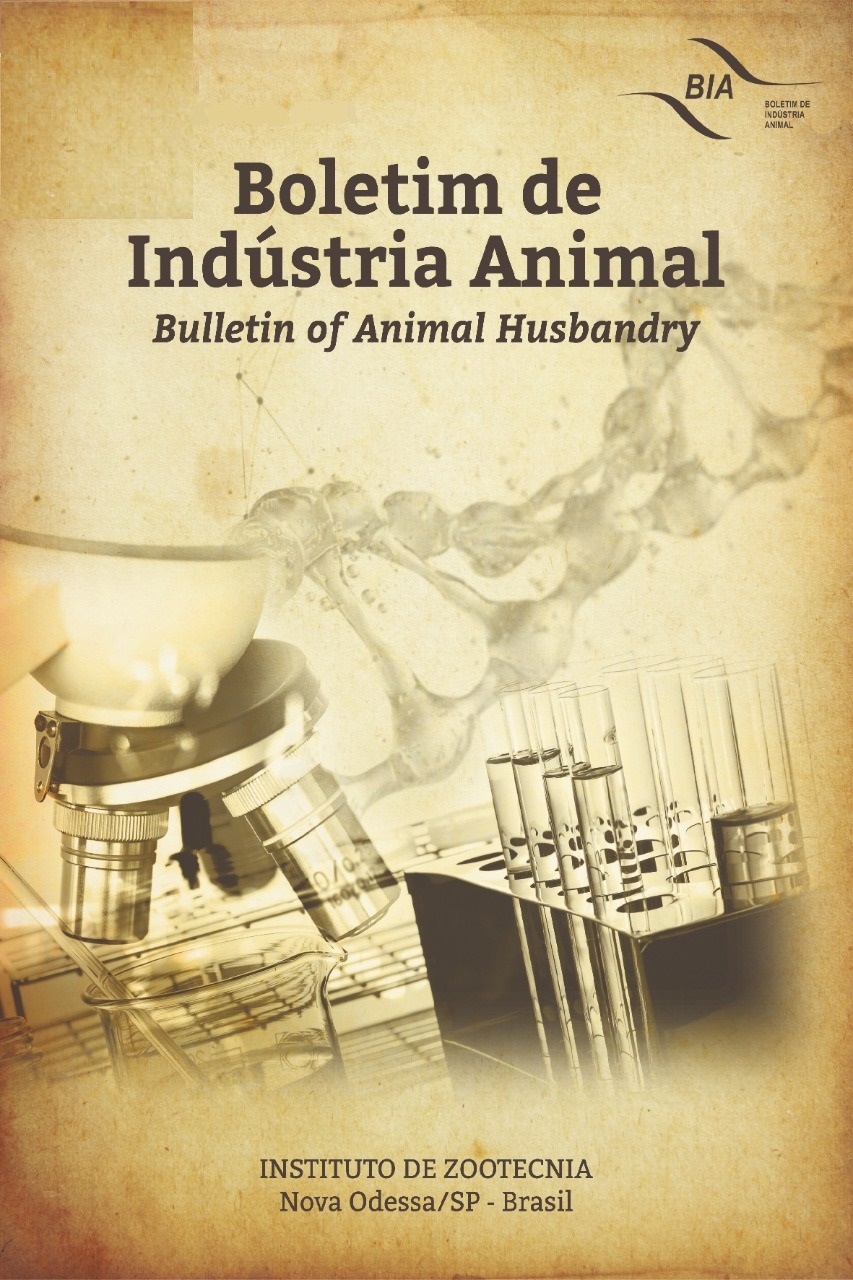Growth and survival of post-larvae of suruvi bocudo (Steindachneridion Scriptum) fed with food enriched with essential thyme oil (Thymus Vulgaris)
DOI:
https://doi.org/10.17523/bia.2025.v82.e1945Palabras clave:
Essencial Oils, Larval Survival, Ration Enriched, Zootechnical DevelopmentResumen
The study aims to assess the zootechnical performance of post-larvae of Steindachneridion scriptum, fed with feed enriched with thyme essential oil (Thymus vulgaris). The experiment employed a control group (T1; control – 0.0%) and feed enriched with varying concentrations of thyme essential oil: T2 (0.1%), T3 (0.5%), T4 (1.0%), T5 (2.0%), and T6 (3.0%). A total of 960 S. scriptum larvae were utilized in experimental units over a 15-day period. Zootechnical performance and histomorphometric analysis were carried out to evaluate the effects of thyme on larval feeding. The increase in villi surface area suggests an increased nutrient absorption capacity in S. scriptum larvae, improving zootechnical results at the 0.5% thyme essential oil concentration. In conclusion, the inclusion of thyme essential oil at a concentration of 0.5% proved effective in enhancing zootechnical outcomes in S. scriptum larvae. However, at higher concentrations, thyme essential oil inclusion demonstrated potential lethality to S. scriptum larvae.
Descargas
Referencias
BARROS, A. F.; VIEIRA, A. N.; SILVA, R. A. C. E; FARIAS, C. F. S.; MARQUES, S. A. D.; MARTINS, M. L. Generating family farming revenue through juvenile fish production: a case study in native species. Acta Scientiarum. Animal Sciences, v.47, 2024. https://doi.org/10.4025/actascianimsci.v47i1.70403
BEHMER O. A.; TOLOSA E. M. C.; FREITAS NETO A.G. Manual de técnicas para histologia normal e patológica. São Paulo: Editora da Universidade de São Paulo, 1976. 241p.
BELATO, K. Análise in vitro da atividade antimicrobiana, citotoxicidade e genotoxicidade de um princípio ativo (Timol) e de um enxaguatório bucal (LISTERINE® ZEROTM). São José dos Campos: [s.n.], 2014. p.1-82.
BJØRGEN, H.; Li, Y.; KORTNER, T.M.; KROGDAHL, Å.; KOPPANG, E.O. Anatomy, immunology, digestive physiology and microbiota of the salmonid intestine: Knowns and unknowns under the impact of an expanding industrialized production. Fish & Shellfish Immunology, 2020. p.172-186. https://doi.org/10.1016/j.fsi.2020.09.032
BRITTO S. G. C.; SIROL R. N.; VIANNA N. C.; JARDIM M.S. SANTOS J. C. DOS; PELISARI J. C. Peixes do rio Paranapanema. São Paulo. Ed. Horizonte, 2008. 86 p.
CANOSA, L.F; BERTUCCI, J.I. The effect of environmental stressors on growth in fish and its endocrine control. Frontiers in Endocrinology (Lausanne), v.14, 2023. https://doi.org/10.3389/fendo.2023.1109461
COSTA, T.S.; SILVA, R.C.; PRETTO, A.; MONTEIRO, O.S.; SIQUEIRA, J.C.; BALDISSEROTTO, B.; LOPES, J.M. Effect of Lippia grata essential oil as a feed additive on the performance of tambatinga juveniles. Acta Amazonica, v.52, p.122-130, 2022. https://doi.org/10.1590/1809-4392202102442
COUTO, T. B. A.; REZENDE, R. S.; AQUINO, P. P. U.; COSTA-PEREIRA, R.; CAMPOS, G. L.; OCCHI, T. V. T.; VITULE, J. R. S.; ESPIRITO-SANTO, H. M. V.; SOARES, Y. F. F.; OLDEN, J. Effects of small hydropower dams on macroinvertebrate and fish assemblages in southern Brazil. Freshwater Biology, v. 68, p.956-971, 2023. https://doi.org/10.1111/fwb.14078
DA SILVA JR, I.I.; DA SILVA, N.P.C.; MARRS, J.A.; CADENA, P.G. Essential Oils Produce Developmental Toxicity in Zebrafish Embryos and Cause Behavior Changes in Zebrafish Larvae. Biomedicines, v.11, 2023. https://doi.org/10.3390/biomedicines11102821
DAWOOD, M.A.O; EL BASUINI, M.F.; YILMAZ, S.; ABDEL-LATIF, H.M.R.; ALAGAWANY, M.; KARI, Z.A.; ABDUL RAZAB, M.K.A.; HAMID, N.K.A.; MOONMANEE, T.; VAN DOAN, H. Exploring the Roles of Dietary Herbal Essential Oils in Aquaculture: A Review. Animals (Basel), v.12, p.823, 2022. https://doi.org/10.3390/ani12070823
FERREIRA, C. M.; ANTONIASSI, N. A. B.; SILVA, F. G.; POVH, J. A.; POTENÇA, A.; MORAES, T.C.H.; SILVA, T.K.S.T.; ABREU, J. S. Características histomorfométricas do intestino de juvenis de tambaqui após uso de probiótico na dieta e durante transporte. Pesquisa Veterinária Brasileira, v.34, p.1258-1260, 2014. https://doi.org/10.1590/S0100-736X2014001200020
FERREIRA, P. M. F.; CALDAS, D. W.; SALARO, A. L.; SARTORI, S. S. R.; OLIVEIRA, J. M.; CARDOSO, A. J. S.; ZUANON, J. A. S. Intestinal and liver morphometry of the Yellow Tail Tetra (Astyanax altiparanae) fed with oregano oil. Anais da Academia Brasileira de Ciências, v.88, p.911-922, 2016. https://doi.org/10.1590/0001-3765201620150202
FIRMINO, J. P.; GALINDO-VILLEGAS, J.; REYES-LÓPEZ, F. E.; GISBERT, E. Phytogenic Bioactive Compounds Shape Fish Mucosal Immunity. Frontiers in Immunology, v.12, 2021. https://doi.org/10.3389/fimmu.2021.695973
FRECCIA, A.; SOUSA, S. M. DE N.; MEURER, F.; BUTZGE, A. J.; MEWES, J. K.; BOMBARDELLI, R.A. Essential oils in the initial phase of broodstock diets of Nile tilapia. Revista Brasileira de Zootecnia, v.43, p.1-7, 2014. https://doi.org/10.1590/S1516-35982014000100001
GHAFARIFARSANI, H.; HOSEINIFAR, S.H.; SHEIKHLAR, A.; RAISSY, M.; CHAHARMAHALI, F.H.; MANEEPITAKSANTI, W.; FAHEEM, M.; VAN DOAN, H. The Effects of Dietary Thyme Oil (Thymus vulgaris) Essential Oils for Common Carp (Cyprinus carpio): Growth Performance, Digestive Enzyme Activity, Antioxidant Defense, Tissue and Mucus Immune Parameters, and Resistance against Aeromonas hydrophila. Aquaculture Nutrition, v.14, 2022. https://doi.org/10.1155/2022/7942506
HOU, T.; SANA, S. S.; LI, H.; XING, Y.; NANDA, A.; NETALA, V. R.; ZHANG, Z. 2022. Essential oils and its antibacterial, antifungal and anti-oxidant activity applications: A review. Food Bioscience, v.47, 2022. https://doi.org/10.1016/j.fbio.2022.101716
JASIM, S. A.; DAVOODI, R.; YASIN, G.; SHICHIYAKH, R. A.; ALKADIR, O. K. A.; TAIFI, A.; MUSTAFA, Y. F.; ABARGHOUEI, S. Potential protective effects of thyme (Thymus vulgaris) essential oil on growth, hematology, immune responses, and antioxidant status of Oncorhynchus mykiss exposed to malathion. Annals of Animal Science, v. 23, p.481-493, 2023. https://doi.org/10.2478/aoas-2022-0064
MAGHELLY, O.R.; HUERGO, G.M.; ZANIBONI-FILHO, E.; ENKE, D.B.S. Características morfométricas e rendimento corporal do Suruvi Steindachneridion scriptum agrupados por sexo. Boletim do Instituto de Pesca, v.40, p.419-430, 2014.
MARCHESE, A.; ORHAN, I. E.; DAGLIA, M.; BARBIERI, R.; DI LORENZO, A.; NABAVI, S.F.; GORTZI, O.; IZADI, M.; NABAVI, S.M. Antibacterial and antifungal activities of thymol: A brief review of the literature. Food Chemistry, v.210, p.402-14, 2016. https://doi.org/10.1016/j.foodchem.2016.04.111
MELLO, H. DE.; MORAES, J. R. E. NIZA, I. G.; MORAES, F. R. DE.; OZÓRIO, R. O. A.; SHIMADA, M. T.; FILHO ENGRACIA, J. R. E. R.; CLAUDIANO, G. S. Efeitos benéficos de probióticos no intestino de juvenis de tilápia-do-nilo. Pesquisa Veterinária Brasileira, v.33, p.724-730, 2013. https://doi.org/10.1590/S0100-736X2013000600006
MINGHETTI, M.; DRIESCHNER, C.; BRAMAZ, N.; SCHUG, H.; SCHIRMER, K. A fish intestinal epithelial barrier model established from the rainbow trout (Oncorhynchus mykiss) cell line, RTgutGC. Cell biology and toxicology, v.33, p.539-555, 2017. https://doi.org/10.1007/s10565-017-9385-x
MINISTÉRIO DO MEIO AMBIENTE (MMA). Portaria MMA nº 148, de 7 de junho de 2022. Altera os Anexos da Portaria nº 443, de 17 de dezembro de 2014, da Portaria nº 444, de 17 de dezembro de 2014, e da Portaria nº 445, de 17 de dezembro de 2014, referentes à atualização da Lista Nacional de Espécies Ameaçadas de Extinção. Disponível em: <https://in.gov.br/en/web/dou/-/portaria-mma-n-148-de-7-de-junho-de-2022-406272733> Acesso 08 de jul de 2024.
MUGWANYA, M.; DAWOOD M.A.O.; KIMERA, F.; SEWILAM, H. Anthropogenic temperature fluctuations and their effect on aquaculture: A comprehensive review. Aquaculture and Fisheries, v. 7, p. 223-243, 2022. https://doi.org/10.1016/j.aaf.2021.12.005
NUNES, C. DE S.; CINSA, L.A. Princípios do processamento histológico de rotina. Revista Interdisciplinar de Estudos Experimentais, v.8, p.31-40, 2016.
PICOLI, F.; LOPES, D. L. DE A.; ZAMPAR, A.; SERAFINI, S.; FRECCIA, A.; VERONEZI, L. O.; KOWALSKI, M.W.; GHIZZO, J. B.; EMERENCIANO, M. G. C. Dietary bee pollen affects hepatic-intestinal histomorphometry of Nile tilapia fingerlings. Aquaculture Research, v.50, p.3295-3304, 2019. https://doi.org/10.1111/are.14287
PRADO, C.; YABU, M. H. S.; GELLER, I. V.; FERNANDES, A. G. J.; LUIZ, M. C.; CARVALHO, S. C. C.; ORSI, M. L. Peixe da vez: Steindachneridion scriptum (Miranda Ribeiro, 1918). Boletim - Sociedade de Ictiologia de Londrina, v.131, p. 40-43, 2020.
REZENDE, R. S.; CARARO, E. R.; CHIMELLO, V.; LIMA-REZENDE, C. A.; MORETTO, Y.; GONÇALVES Jr, J. F. Small hydropower plants lead to higher litter breakdown rates in by-passed sections than in impounded reaches. Aquatic Science, v.85, p.26, 2023. https://doi.org/10.1007/s00027-022-00926-8
SCHUTZ, J.; WEINGARTNER, M. Crescimento e sobrevivência de larvas de suruvi Steindachneridion scriptum nos primeiros dias de vida: influência de diferentes alimentos e fotoperíodos. Boletin do Instituto de Pesca, v. 34, p.443-451, 2008.
SOUZA, C.F.; BALDISSERA, M.D.; BALDISSEROTTO, B.; HEINZMANN, B.M.; MARTOS-SITCHA, J.A.; MANCERA, J.M. Essential Oils as Stress-Reducing Agents for Fish Aquaculture: A Review. Frontiers in Physiology, v.10, p.785, 2019. https://doi.org/10.3389/fphys.2019.00785
TOMAZELLI JÚNIOR, O.; KUHN, F.; PADILHA, P. J. M.; VICENTE, L. R.M.; COSTA, S. W.; BOLIGON, A. A.; SCAPINELLO, J.; NESI, C. N.; DAL MAGRO, J.; LAMO CASTELLVÍ, S. 2018. Microencapsulation of essential thyme oil by spray drying and its antimicrobial evaluation against vibrio alginolyticus and vibrio parahaemolyticus. Brazilian Journal of Biology, v.78, p. 311-317, 2018. https://doi.org/10.1590/1519-6984.08716
VALENTI, W. C.; BARROS, H. P.; MORAES-VALENTI, P.; BUENO, G. W.; CAVALLI, R. Aquaculture in Brazil: past, present and future. Aquaculture Reports, v. 19, p. 100611, 2021. https://doi.org/10.1016/j.aqrep.2021.100611
VIANA, J. S.; STERZELECKI, F. C.; SUGAI, J. K.; NUÑER, A.P.O. Feeding frequency in rearing juveniles of suruvi Steindachneridion scriptum. Boletim do Instituto de Pesca, v. 46(3), 2020. https://doi.org/10.20950/1678-2305.2020.46.3.594
WALTON, K.D.; FREDDO, A.M.; WANG, S., GUMUCIO, D.L. Generation of intestinal surface: an absorbing tale. Development, v. 143(13), p.2261-72, 2016. https://doi.org/10.1242/dev.135400
WANG, R.; MOHAMMADI, M.; MAHBOUBI, A.; TAHERZADEH, M. J. In-vitro digestion models: a critical review for human and fish and a protocol for in-vitro digestion in fish. Bioengineered, v. 12, p.3040-3064, 2021. https://doi.org/10.1080/21655979.2021.1940769
ZARGAR, A.; RAHIMI-AFZAL, Z.; SOLTANI, E.; TAHERI MIRGHAED, A; EBRAHIMZADEH-MOUSAVI SOLTANI, M.; YUOSEFI, P. Growth performance, immune response and disease resistance of rainbow trout (Oncorhynchus mykiss) fed Thymus vulgaris essential oils. Aquaculture Research, v.50, p. 3097-3106, 2019. https://doi.org/10.1111/are.14243
Descargas
Publicado
Número
Sección
Licencia
Derechos de autor 2025 Boletín de Industria Animal

Esta obra está bajo una licencia internacional Creative Commons Atribución-NoComercial-SinDerivadas 4.0.
Os autores não serão remunerados pela publicação de trabalhos, pois devem abrir mão de seus direitos autorais em favor deste periódico. Por outro lado, os autores ficam autorizados a publicar seus artigos, simultaneamente, em repositórios da instituição de sua origem, desde que citada a fonte da publicação original seja Boletim de Indústria Animal. A revista se reserva o direito de efetuar, nos originais, alterações de ordem normativa, ortográfica e gramatical, com vistas a manter o padrão culto da língua e a credibilidade do veículo. Respeitará, no entanto, o estilo de escrever dos autores. Alterações, correções ou sugestões de ordem conceitual serão encaminhadas aos autores, quando necessário. Nesses casos, os artigos, depois de adequados, deverão ser submetidos a nova apreciação. As opiniões emitidas pelos autores dos artigos são de sua exclusiva responsabilidade. Todo o conteúdo deste periódico, exceto onde está identificado, está licenciado sob a Licença Creative Commons Attribution (CC-BY-NC). A condição BY implica que os licenciados podem copiar, distribuir, exibir e executar a obra e fazer trabalhos derivados com base em que só se dão o autor ou licenciante os créditos na forma especificada por estes. A cláusula NC significa que os licenciados podem copiar, distribuir, exibir e executar a obra e fazer trabalhos derivados com base apenas para fins não comerciais.













